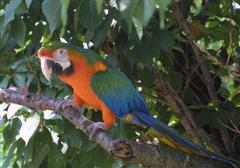Macaw - Catalina
Rainbow Macaw Scientific Name: Ara ararauna x macao
Mon, 30th June, 2025 - 8:58 pm GMT
Sponsor Ads:

Alternative Name
Rainbow Macaw Scientific Name: Ara ararauna x macaoBasic Info
Catalina or Rainbow Macaws grow to about 34 inches in length, and are characterized by their incredibly varied and bright plumage! The wings are mostly orange-yellow with orange-yellow undersides and blue edging topside. Their chests are gold-yellow, topped by a blue-green head with a green crown! The beak is horn colored. The back of the neck and back are shaded orange and the Catalina Macaw's tail is tapered and quite long. Generally, Catalina Macaws do not like to have their tail feathers touched! Catalina Macaws look a lot like Harlequin Macaws and the two are often confused.
Health
Catalina Macaws enjoy bathing and should always have fresh water. Catalina Macaws should be fed a wide variety of fruits and vegetables, greens, grains, nuts, seeds, and a mineral supplement along with peanut butter or other fatty, high-protein treats. They may be hand-reared on biscuit, porridge, and white bread. Catalina Macaws are a bit more expensive than other purebred Macaws and may be quite hard to find. Catalina Macaws have been used to make still more varied hybrids: a Camelot Macaw is a cross between a Scarlet and Catalina Macaw, and a Flame Macaw is a cross between a Green-Winged Macaw and a Catalina. Breeding Offspring may vary greatly in coloration when two hybrid Macaws such as Catalinas are crossed. Generally, eggs incubate for about four weeks and the clutch consists of two to three eggs. While the parents are raising their young, you should supplement their diet with extra green food, carrots, maize, and a vitamin supplement. The fledgling period lasts for about three months. Baby Catalina Macaws should be hand fed after this and socialized in order to make them better, tamer pets!Habitat
N/ABehavior
Most people are divided on the question of hybrid Macaws: some seem to love them, and others believe they should not be bred to keep natural Macaw bloodlines pure. Regardless of your political opinion, however, there is no dispute that the Catalina Macaw hybrid is an exquisitely gorgeous bird! Catalina Macaws, known as Rainbow Macaws in Australia, have the same noisy, intelligent, playful personalities as their naturally occurring counterparts! They need a large outdoor aviary of 24 by nine by six feet with an enclosed shelter, constructed of strong wire or chain link. These birds are avid chewers and need plenty of wood, as bored Catalina Macaws will be destructive, chewing on their cage or anything else they can find! Plenty of attention and love is a must with Catalina Macaws, and will be well rewarded as these birds form strong bonds with their handlers and are good talkers! Highly inquisitive by nature, Catalina Macaws relate to the world by chewing on things, "feeling" them with their mouths! This means gentle biting characterizes their behavior, but sharp bites are only inflicted when the Macaw is extremely upset or frightened. Catalina Macaws enjoy bathing and should always have fresh water. Catalina Macaws live nicely with other birds, but may become aggressive during breeding season, when they should be treated cautiously.Origin
N/AHistory
Catalina Macaws do not occur naturally in the wild, but are a domestic cross of Blue and Gold and Scarlet Macaws. Usually the mother is the Blue and Gold Macaw because Scarlet Macaw females are a bit rare. Many people are against hybrid Macaw ownership because they believe Macaw bloodlines should be kept pure since many Macaws are disappearing in the wild. Because hybrid Macaws look very similar to purebred Macaws, the difference would show up only in the offspring and Macaw bloodlines might be tainted, losing natural Macaw breeds forever.Common Foods
Catalina Macaws should be fed a wide variety of fruits and vegetables, greens, grains, nuts, seeds, and a mineral supplement along with peanut butter or other fatty, high-protein treats. They may be hand-reared on biscuit, porridge, and white bread.Sponsor Ads:
If more than one person is responsible for a miscalculation, no one will be at fault. -- Unknown
Macaw - Catalina
Coded by: BGID® | ALL RIGHTS RESERVED Copyright © 2000-2025
Disclaimer | Privacy | Report Errors / Contact | Credits








 Why haven't we as a collective earth met with aliens yet?
Why haven't we as a collective earth met with aliens yet?  World EcoSystem - Biodiversity Changes - Who is on board and who isn
World EcoSystem - Biodiversity Changes - Who is on board and who isn  Homosexual behavior stems from the mind or genetics?
Homosexual behavior stems from the mind or genetics?  The Best Text Adventure You Will Ever Play! The official site:
The Best Text Adventure You Will Ever Play! The official site:  Mouthwash - Mouthrinse - Mouth Sores - Healing Infections - Gingivitis
Mouthwash - Mouthrinse - Mouth Sores - Healing Infections - Gingivitis  Treatment for Depression
Treatment for Depression  Ultra radical and violent Islamist group that even rivals Al Qaeda
Ultra radical and violent Islamist group that even rivals Al Qaeda  An idea to have teachers who want to carry guns to school undergo some level of police training will be left up to local school districts and police departments.
An idea to have teachers who want to carry guns to school undergo some level of police training will be left up to local school districts and police departments.